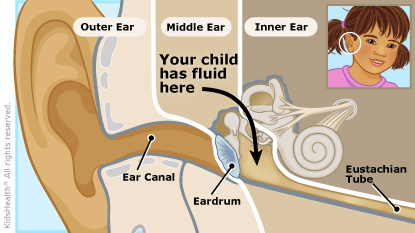Fluid in the Middle Ear: How to Care for Your Child
Fluid is often found in the middle ear after a child recovers from an ear infection. Sometimes it happens without an ear infection. It usually gets better on its own in a few weeks or months.


-
Most of the time, no special care or medicines are needed. Only give over-the-counter medicines if your health care provider recommends them.
-
These things may help prevent fluid in the middle ear from coming back:
-
Don't smoke or allow others to smoke around your child. If anyone in your household smokes, call 1-800-QUIT-NOW (800-784-8669) or visit smokefree.gov for advice and tips on quitting.
-
Breastfeed babies, if possible. If bottle-feeding, hold your baby at an angle (so the head is above the belly) and not horizontally.
-
Help your child avoid things he or she is allergic to.
-
Follow up as recommended by your health care provider.
Fluid in the middle ear isn't contagious (can't be spread to others), but a cold or other virus that can cause an ear infection or fluid in the middle ear is contagious. To prevent spreading colds and other viruses:
-
Teach all family members to wash their hands well and often. They should use soap and water and scrub their hands for at least 20 seconds, rinse, and dry thoroughly. If soap and water aren't available, a hand sanitizer with at least 60% alcohol can be used.
-
Help your child avoid other people with colds, if possible.
-
Clean tabletops, doorknobs, and other hard surfaces regularly. Use a cleaner that kills viruses.
-
If your child goes to child care, check to make sure that objects and surfaces are cleaned often, and that tissues, soap and water, paper towels, hand sanitizer, and throwaway wipes are easy to find.

Your child:
-
has pain in the ear
-
develops a fever
-
has liquid or blood coming from the ear
-
doesn't seem to hear well
-
isn't talking clearly or learning new words as well as expected

Where does fluid in the middle ear come from? The middle ear is the space just behind the eardrum. Normally, mucus drains from the middle ear into the throat through the eustachian tube. When kids have an ear infection, cold, or allergies, the tube can swell. This blocks the mucus from draining out, leading to fluid in the middle ear. Sometimes, something else blocks the eustachian tube, like large adenoids. And sometimes there's no clear reason why fluid is in the middle ear.
Fluid in the middle ear also is called otitis media (oh-TYE-tis ME-dee-ah) with effusion.
What does fluid in the middle ear feel like? Many kids don't feel anything at all. Others may feel fullness in the ear or "popping." The fluid can block sound and make it harder to hear. Some kids may have trouble sleeping, dizziness, or problems with balance.
What's the difference between fluid in the middle ear and a middle ear infection? Fluid in the middle ear is different from an ear infection. An ear infection happens when pus (infected fluid) builds up behind the eardrum. This makes the eardrum bulge, which can be painful. In otitis media with effusion, the fluid behind the eardrum isn't infected and doesn't make the eardrum bulge, so it usually won't cause pain.
What do health care providers do when a child has fluid in the middle ear? The health care provider will likely want to check your child again to make sure that the fluid went away. If it didn't, they might want to do a hearing test. In some cases, surgery might be needed.